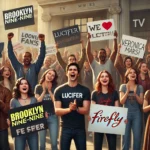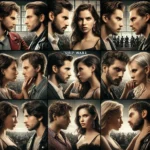In the world of cinema, certain scenes have become etched in the collective memory of fans. These moments — whether filled with heart-pounding action, poignant emotion, or awe-inspiring visuals — are what make films timeless. For many, the love for these iconic scenes goes beyond simply watching them. Fan artists around the globe take these beloved moments and recreate them with their own creative twist, offering unique interpretations that show not just their technical skill, but also a deep passion for film.
In this spotlight, we’ll explore some of the most impressive fan art that reimagines famous film scenes, giving them new life through different artistic mediums and styles. From digital illustrations to hand-drawn sketches, each piece provides a fresh perspective on moments we thought we knew inside and out.
Star Wars: The Duel on Mustafar – Digital Fantasy
Arguably one of the most dramatic and visually stunning scenes in the Star Wars saga, the duel between Obi-Wan Kenobi and Anakin Skywalker on Mustafar has inspired countless artists. One such fan artist has taken this iconic battle and reimagined it in a dreamy, almost abstract art style. The lava flows that rage around the combatants have been turned into swirling, ethereal flames, creating an even more surreal, apocalyptic landscape. The colors are vivid and exaggerated, making the characters seem like mythological figures locked in an eternal struggle.
Artistic Takeaway: This reinterpretation uses color and abstraction to elevate the emotions of the scene, showing how altering a few key elements can transform a familiar moment into something completely new.
The Shining: The Grady Twins – Watercolor Horror
The Shining has given us some of the most iconic horror imagery, and the Grady twins are unforgettable. One fan artist reimagines their eerie presence through the delicate and soft medium of watercolor. The contrast between the disturbing nature of the twins and the gentle strokes of watercolor adds an unsettling layer to the already creepy scene. The artist retains the twins’ blank stares and identical dresses, but their ghostly figures seem to blend into the background, giving the impression that they could disappear at any moment.
Artistic Takeaway: By using an unexpected medium, this artist enhances the unsettling tone of the scene, proving that horror can be conveyed in more subtle, nuanced ways.
Jurassic Park: The T. rex Breakout – Hand-Drawn Sketches
The T. rex breakout scene from Jurassic Park is an adrenaline-fueled moment that has been interpreted by countless artists, but one particular sketch artist chose to break it down frame by frame. This artist painstakingly recreated the tension of the moment in black-and-white sketches, focusing on the intensity in each character’s expression and the looming presence of the T. rex. The absence of color doesn’t diminish the power of the scene; rather, it sharpens the focus on the raw emotion and fear that dominates the moment.
Artistic Takeaway: Through careful attention to detail and composition, even the simplest forms of art like sketching can convey the immense tension and fear found in a cinematic masterpiece.
The Matrix: Neo’s Bullet Dodge – Minimalist Digital Art
The slow-motion bullet-dodging scene from The Matrix is one of the most visually iconic moments in film history. A fan artist reimagined this moment in minimalist digital form, reducing Neo and the bullets to simple geometric shapes and lines. Despite the simplicity, the scene remains instantly recognizable. The artist plays with perspective and negative space, turning the high-tech visual effects into a clean and elegant design, highlighting the core elements that make the scene iconic.
Artistic Takeaway: Minimalism in art can still capture the essence of a scene by focusing on its most identifiable and essential features.
Spirited Away: Chihiro’s Train Ride – Pastel Impressions
Hayao Miyazaki’s Spirited Away has inspired numerous fan art interpretations, and one of the most serene scenes — Chihiro’s quiet train ride — has been captured in beautiful pastel tones. The artist uses soft colors to reflect the dreamlike atmosphere of the film, with the reflections in the water under the train depicted in hazy, blurred strokes. The peacefulness of the moment is preserved, and the soft edges and gentle lighting give the piece an ethereal quality, much like the original animation.
Artistic Takeaway: The use of pastels here mirrors the delicate and calming nature of the scene, reminding us how important the choice of color and technique is when reinterpreting iconic cinematic moments.
Blade Runner: Roy Batty’s “Tears in Rain” Speech – Collage Art
In Blade Runner, the “Tears in Rain” monologue is a cinematic moment that blends visual beauty with deep philosophical reflection. One fan artist decided to portray this powerful scene through a collage of textures and materials. By layering different images, including rain-drenched urban landscapes, fragments of dialogue, and hazy images of Roy Batty, the piece creates a fragmented but poignant interpretation. The choice of mixed media adds to the chaotic beauty of the moment, capturing both the melancholy and the existential weight of Batty’s final words.
Artistic Takeaway: Collage art provides a dynamic way to explore the layered meanings within a scene, offering a textured, multifaceted approach to storytelling through visuals.
Fan art is more than just an homage to the films we love — it’s a form of personal expression that allows artists to engage with their favorite movies in creative and innovative ways. Each of these reimaginings brings something new to the table, showing that even the most iconic moments in cinema can be viewed through countless different lenses. Whether through surreal abstraction, minimalist design, or detailed sketching, these works of art remind us that film and art are mediums that continually inspire one another.


